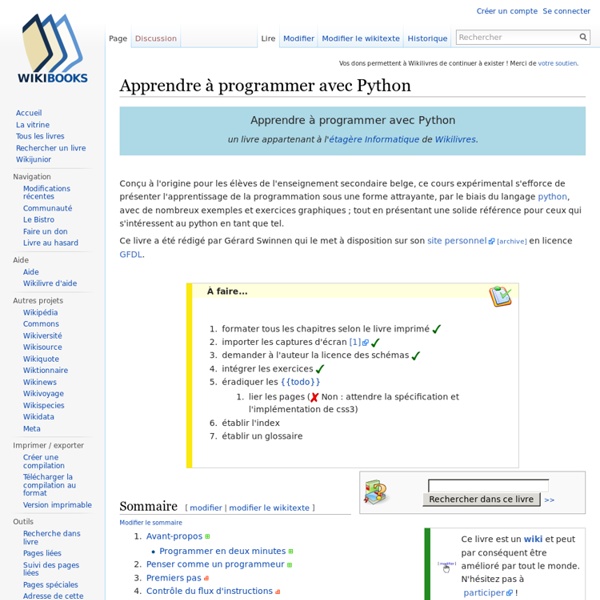



The Official web2py Book I believe that the ability to easily build high quality web applications is of critical importance for the growth of a free and open society. This prevents the biggest players from monopolizing the flow of information. Hence I started the web2py project in 2007, primarily as a teaching tool with the goal of making web development easier, faster, and more secure. As a result, in 2011, web2py won the Bossie Award for best Open Source Development Software, and in 2012 it won the Technology of the Year award from InfoWorld. As you will learn in the following pages, web2py tries to lower the barrier of entry to web development by focusing on three main goals: Ease of use. Rapid development. Security. web2py is built from the user perspective and is constantly being optimized internally to become faster and leaner, whilst always maintaining backwards compatibility. web2py provides its users with the generous freedoms of the LGPL open source licence.
19.13. xml.etree.ElementTree — The ElementTree XML API — Python v2.7.2 documentation The Element type is a flexible container object, designed to store hierarchical data structures in memory. The type can be described as a cross between a list and a dictionary. To create an element instance, use the Element constructor or the SubElement() factory function. The ElementTree class can be used to wrap an element structure, and convert it from and to XML. A C implementation of this API is available as xml.etree.cElementTree. See for tutorials and links to other docs. 19.7.1. This is a short tutorial for using xml.etree.ElementTree (ET in short). 19.7.1.1. XML is an inherently hierarchical data format, and the most natural way to represent it is with a tree. 19.7.1.2. We’ll be using the following XML document as the sample data for this section: <? We have a number of ways to import the data. import xml.etree.ElementTree as ETtree = ET.parse('country_data.xml')root = tree.getroot() Reading the data from a string: >>> root[0][1].text'2008' <? <?
Karrigell/Home page Home page[edit] For the moment we'll ignore the CDs and begin writing the home page Create a new folder mycds in your Karrigell distribution, under the www folder. def index(): print "<h1>My CD collection</h1>" In your browser ask localhost/mycds/index.ks/index The extension "ks" (Karrigell Service) means that the script is a Python script where functions match urls : here, index.ks/index means that the function index() will send the data back to the browser In fact if you don't specify a function name, the index() function in the script will be run, so you could have asked localhost/mycds/index.ksand if you don't even specify a script name in a folder, the script called index will be run. Notice the print statement in the index() function. Adding a page counter[edit] The page counter will print the number of times that the page has been seen. Each time the page is reloaded, you will see the number of visits incremented by 1 A better page counter[edit] Use the built-in Session() function
Python | Le Mad Blog Vous êtes djangonautes ? Et vous n’avez pas encore acheté votre billet pour DjangoCon Europe ? Alors peut-être que vous ne le saviez pas. Après tout, même si on a essayé de faire un maximum de com sur le sujet, on n’en fait jamais assez et il est fort possible que vous soyez passé à coté. Donc, je vous refais un petit topo. 3 jours de confs du 13 au 15 mai et 2 jours de sprint le 16 et 17 mai. Mais surtout, surtout, ce ne sont pas trois jours de confs dans une simple salle de conf, aussi belle soit-elle. Non, ce sont trois jours de confs (et 2 jours de sprint) dans une île. Imaginez donc la scéne. Et puis après 10 minutes d’une aventureuse traversée, vous accosterez, tel Jim Hawkins, sur l’île des poneys ! Et puis on s’est dit que comme c’était sur une île, y il y avait donc des plages. En fait, la seule chose que l’on ne fournit pas, c’est la crème solaire. Bon après vous allez me dire que tout ça, c’est bien beau. Vous voulez comprendre à quoi sert App Loading ?
Python fr:Préface You have seen how you can reuse code in your program by defining functions once. What if you wanted to reuse a number of functions in other programs that you write? As you might have guessed, the answer is modules. There are various methods of writing modules, but the simplest way is to create a file with a .py extension that contains functions and variables. Another method is to write the modules in the native language in which the Python interpreter itself was written. A module can be imported by another program to make use of its functionality. Example (save as module_using_sys.py): import sys print('The command line arguments are:')for i in sys.argv: print i print '\n\nThe PYTHONPATH is', sys.path, '\n' $ python module_using_sys.py The command line arguments are: module_using_sys.py we are arguments The PYTHONPATH is ['/tmp/py', # many entries here, not shown here '/Library/Python/2.7/site-packages', '/usr/local/lib/python2.7/site-packages'] How It Works 11.1. 11.2. 11.3. 11.4. 11.5.